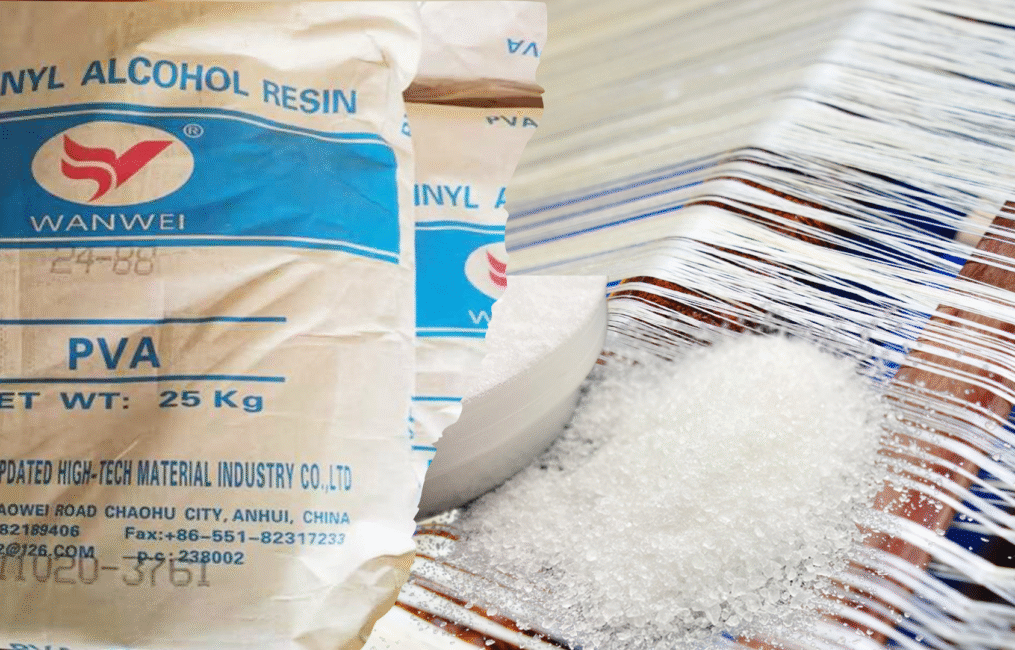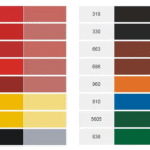استخدام PVA في تحديد حجم الالتواء
كحول البولي فينيل (PVA) هو عامل تحديد حجم الاعوجاج شائع الاستخدام، ويُقدّر لالتصاقه الممتاز بالألياف المحبة للماء والكارهة له. يُشكّل أغشيةً متينةً ومقاومةً للتآكل، ويمتزج جيدًا مع عوامل تحديد حجم أخرى مثل النشا وحمض البولي أكريليك، مما يُحسّن أداء التحديد العام. يوفر كحول البولي فينيل المُحلل بالكامل التصاقًا قويًا، ولكنه يصعب إذابته وإزالة حجمه، بينما تُعدّ الأصناف المُحللة جزئيًا أسهل في التعامل، ولكنها عُرضة للرغوة. على الرغم من أن كحول البولي فينيل غير سام، إلا أن بطء تحلله البيولوجي يحدّ من جاذبيته البيئية. وتُبذل جهودٌ مُستمرة لتحسين ملاءمته للبيئة وتكييف خصائصه مع متطلبات النسيج عالي السرعة الحديثة. على الرغم من هذه التحديات، لا يزال كحول البولي فينيل أحد أكثر مواد تحديد حجم المنسوجات فعاليةً وموثوقيةً في الاستخدام اليوم.

Sizing Performance of PVA Sizing Agent
PVA sizing agent is a crucial material in textile sizing, mainly for three reasons:
- Excellent Adhesion: PVA exhibits outstanding adhesion to both hydrophilic fibers (e.g., fully hydrolyzed PVA for cotton) and hydrophobic fibers (e.g., partially hydrolyzed PVA for polyester).
- Superior Film Properties: Regardless of whether it is fully or partially hydrolyzed, PVA sizing films possess excellent toughness and abrasion resistance, often excessively high (high cohesion), which can cause difficulty in yarn separation.
- Good Compatibility: PVA sizing agent blends well with all other sizing agents, including starch-based agents, polyacrylic acid-based agents, and water-dispersible polyester agents. Adding an appropriate proportion of PVA can significantly enhance the film properties of these other sizing agents.
Thus, PVA is currently considered the sizing agent with the best overall sizing performance.
Adaptability of PVA Grades
In China, PVA is mainly produced by large state-owned enterprises. Various grades covering a wide range of degrees of polymerization (300–3000) and degrees of hydrolysis (80%–100%) are available, with viscosities from 3.0 mPa·s to 90 mPa·s, in both granule and powder forms. However, non-standard grades of PVA are much more expensive than conventional ones. Currently, the main PVAs used for warp sizing are:
- PVA 1799 و PVA 1788 (degree of polymerization around 1700)
- PVA 0588 (degree of polymerization around 500)
PVA with a polymerization degree of 1700 has too high viscosity and is not suitable for today’s low-viscosity, high-concentration sizing processes.
Quality of Partially Hydrolyzed PVA
Compared to fully hydrolyzed PVA, partially hydrolyzed PVA offers many advantages, including:
- Better solubility
- Easier desizing
- Stronger adhesion to hydrophobic fibers (like polyester)
- Particularly, PVA 0588 has a low viscosity feature.
Due to its molecular structure, partially hydrolyzed PVA has both hydrophilic (-OH) and hydrophobic (-OOCCH₃) groups, resembling surfactants. This structure tends to produce foam, and the foam is highly stable. Therefore, anti-foaming performance is a crucial quality indicator for partially hydrolyzed PVA.
Although some Chinese manufacturers can produce partially hydrolyzed PVA, their products still lag behind international brands, especially regarding anti-foaming performance.
Thus:
- For fully hydrolyzed PVA, the focus should be on lowering polymerization degree and appropriately reducing hydrolysis degree.
- For partially hydrolyzed PVA, solving the foaming issue و improving product quality are key priorities.
Desizing Performance of PVA
PVA sizing agents are generally regarded as difficult to desize. There are two basic methods for desizing: dissolution و chemical decomposition.
- Solubility is mainly related to the degree of hydrolysis:
- Fully hydrolyzed PVA (e.g., PVA 1799) dissolves poorly and requires temperatures above 95°C for over 30 minutes.
- Partially hydrolyzed PVAs (e.g., PVA 1788, PVA 0588) dissolve at 60°C–80°C within a short time.
Since warp sizing mainly uses PVA 1799, desizing remains challenging.
Regardless of the type, PVA’s molecular backbone is entirely composed of C–C bonds, making it chemically very stable. Thus, printing and dyeing plants typically use high-temperature (above 95°C) alkaline peroxide oxidation methods to desize PVA.
Environmental Friendliness of PVA
The environmental assessment of sizing agents mainly considers toxicity و biodegradability.
- سمية: PVA is non-toxic.
- Biodegradability: PVA is technically biodegradable and is classified as a biodegradable synthetic polymer in industries like coatings and adhesives. However, its biodegradation rate is very slow:
- Over 3 months in water
- Over 2 years in soil
Biodegradability values (BOD₅/COD₍Cr₎):
- PVA 1788: 0.009
- PVA 1799: 0.004
- Corn Starch: 0.641
- Polyacrylamide: 0.533
- Water-dispersible polyester sizing agent: 0.054
Because of its slow biodegradability, PVA in China is regarded as a material that should be “used less or avoided for warp sizing.”
خاتمة
Considering fiber adhesion, film performance, and compatibility with other sizing agents, PVA sizing agents currently offer the best overall sizing performance. However, due to its poor biodegradability, its application faces certain restrictions.
Warp Sizing and Desizing
Why Warp Sizing Is Necessary and Its Principles
Principles of Warp Sizing:
- Action of Sizing Liquor: The sizing solution, usually composed of water, starch, adhesives, thickeners, antistatic agents, etc., forms a protective film on the warp yarn surface, increasing fiber bonding and enhancing abrasion resistance.
- Fiber Coating Effect: Sizing liquor penetrates between and around fibers, forming a thin adhesive film that smoothens the surface and improves tensile strength and friction resistance.
- Friction Reduction: Sizing greatly reduces friction between yarns and machine components, lowering the risk of yarn damage and breakage during weaving.
- Enhancing Yarn Toughness: Sized yarns have greater toughness and stability, better withstanding loom tension and impact, ensuring smooth weaving operations.
Why Warp Sizing Is Necessary:
- Improve Weaving Efficiency: Reduces yarn breakage frequency, minimizes loom downtime, and boosts production efficiency.
- Reduce Wear and Tear: Minimizes yarn and machine part friction, extending machinery life and reducing maintenance needs.
- Enhance Fabric Quality: Produces fabrics with smoother, more uniform surfaces, improving the final appearance.
- Strengthen Fabric Durability: Sized yarns endure higher tension during weaving, enhancing final fabric strength.
Why Desizing Is Necessary and How to Perform It
In textile production, desizing is an essential step after sizing. It removes the residual sizing agents on yarns or fabrics, allowing subsequent processes (like dyeing or finishing) to proceed smoothly.
Necessity of Desizing:
- Improve Dyeing and Finishing: Sizing agents hinder dye and finish absorption. Without desizing, uneven dyeing and poor finishing results occur.
- Reduce Fabric Stiffness: Desizing removes the stiffness caused by sizing, restoring yarn flexibility for better weaving and further processing.
- Decrease Fabric Gloss: Sizing often adds unwanted shine; desizing restores a more natural fabric appearance.
- Prevent Odors: Residual sizing can cause odors during later processing. Desizing helps maintain fabric quality.
Methods of Desizing:
- Water Washing Desizing:
- Washing in hot or warm water, often with desizing agents, especially for starch-based sizes.
- Typical temperatures range from 60°C to 90°C, depending on sizing type and yarn material.
- Chemical Desizing:
- Uses desizing enzymes, acids, or alkalis to chemically break down the sizing.
- Enzymatic desizing is especially popular for its efficiency and mildness, reducing fiber damage.
- Mechanical Desizing:
- Employs high-pressure water jets or mechanical friction to physically remove sizing agents.
- Suitable for special or high-strength yarns but requires care to prevent yarn damage.
- Acid or Alkali Desizing:
- For specific types of sizing (e.g., synthetic polymer sizes), acid (like dilute sulfuric acid) or alkali (like sodium hydroxide) treatments are used for effective removal.
Overview of the Development of Textile Sizing Agents
| Type of Sizing Agent | Development Overview | Main Advantages | Main Problems | Development Direction |
|---|---|---|---|---|
| Starch and Modified Starch | The earliest sizing agent used; modified starch became popular since the 1980s. | Widely available, low cost, easy to desize (via amylase). | High viscosity, poor fluidity, average adhesion to fibers, brittle sizing film. | Improve film toughness, enhance product stability, reduce gelation at low temperature. |
| Polyvinyl Alcohol (PVA) | Applied since the 1960s, remains a key sizing agent due to excellent performance. | Strong adhesion to both hydrophilic and hydrophobic fibers, tough and abrasion-resistant film, good compatibility with other agents. | Poor biodegradability; fully hydrolyzed types are hard to desize; partially hydrolyzed types may cause foaming. | Develop low-degree polymerization and optimized hydrolysis grades of PVA; improve biodegradability. |
| Polyacrylic Acid-Based Agents | Used since the late 1970s, developed rapidly in the 1980s–1990s. | Adjustable properties, good adhesion, excellent film-forming ability. | High cost, high moisture absorption, poor compatibility with starch. | Reduce cost, develop truly solid low-viscosity agents suitable for sizing. |
| Water-Dispersible Polyester | Rapid development since early 21st century; now the fourth major type. | Excellent adhesion to polyester, low viscosity, good fiber penetration, relatively low cost. | Poor solubility in hard water, electrolytes, alkalis; average compatibility; biodegradability and desizing need improvement. | Improve solubility and compatibility; optimize desizing performance and environmental properties. |



